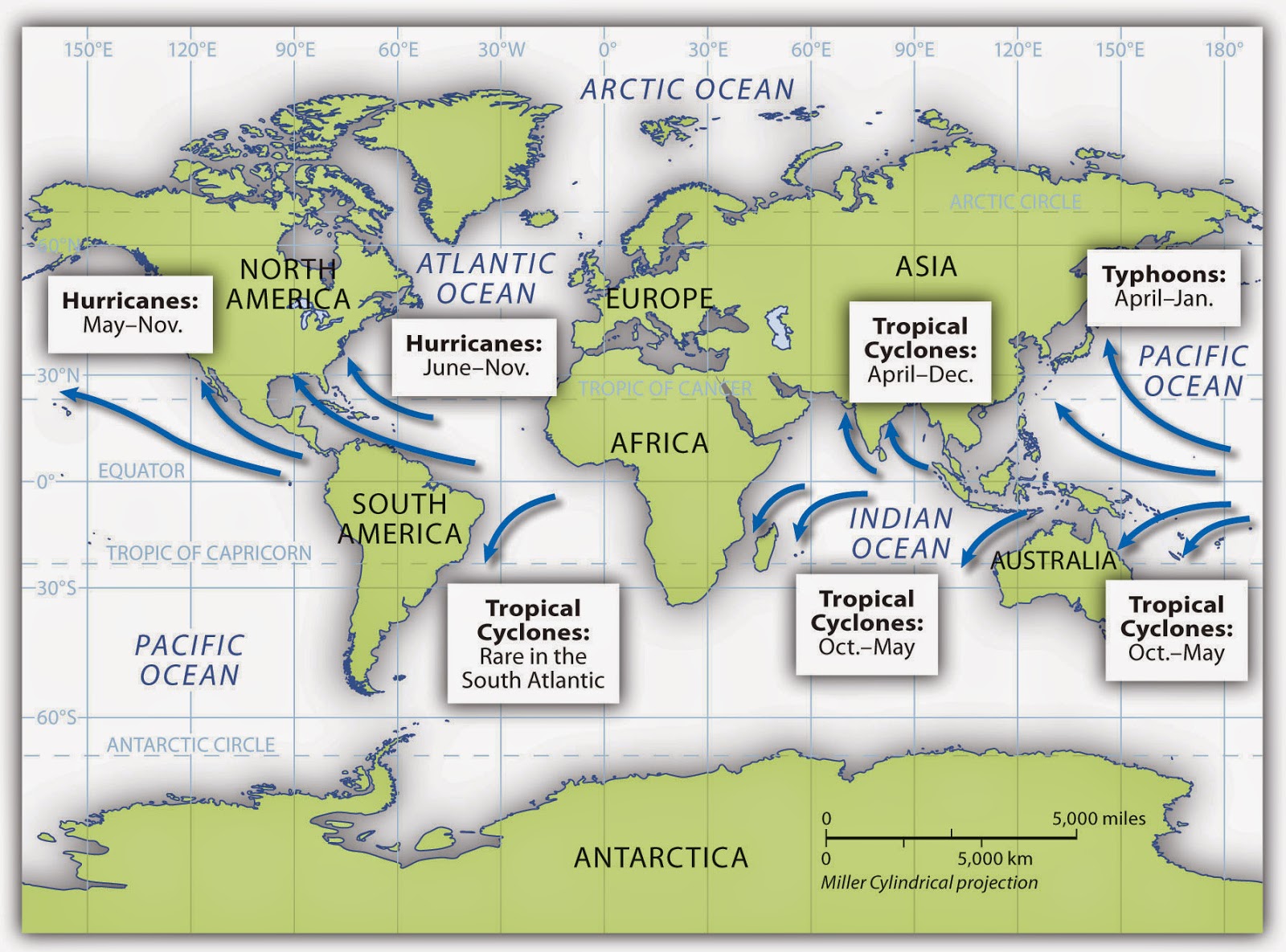All about Cyclone
As the tropical cyclone named Hudhud originated in Andaman sea is approaching landfall to Andhra Pradesh and Orrisa, its very important for us to know each and every bit of it and also about its siblings who has already visited India and neighboring countries or are yet to visit.
What you should know about cyclones
Courtesy: Google, Wikipedia, WMD, IMD, WunderMap
What you should know about cyclones
- Definitions
- What are the Process of cyclone Formation
- What are different monitoring and naming organization
Definitions
Tropical storms, cyclones, hurricanes and typhoons, although named differently, describe the same disaster type.
Essentially, these disaster types refer to a large scale closed circulation system in the atmosphere which combines low pressure and strong winds that rotate in same direction as Earth. This is usually characterized by inward spiraling winds that rotate anti-clockwise in the Northern Hemisphere and clockwise in the Southern Hemisphere of the Earth.
The system is referred to as a "cyclone" in the Indian Ocean and and South Pacific, "hurricane" in the Western Atlantic and Eastern Pacific and "typhoon" in the Western Pacific.
Essentially, these disaster types refer to a large scale closed circulation system in the atmosphere which combines low pressure and strong winds that rotate in same direction as Earth. This is usually characterized by inward spiraling winds that rotate anti-clockwise in the Northern Hemisphere and clockwise in the Southern Hemisphere of the Earth.
The system is referred to as a "cyclone" in the Indian Ocean and and South Pacific, "hurricane" in the Western Atlantic and Eastern Pacific and "typhoon" in the Western Pacific.
Process of Cyclone Formation
Cyclogenesis describes the process of cyclone formation and intensification
Scale of Measurement
- Macroscale: The macroscale deals with systems with global size.
- Synoptic scale: Synoptic scale systems cover a portion of a continent, such as extratropical cyclones, with dimensions of 1,000-2,500 km (620-1,550 mi) across
- Mesoscale: The mesoscale is the next smaller scale, and often is divided into two ranges: meso-alpha phenomena range from 200-2,000 km (125-1,243 mi) across (the realm of the tropical cyclone), while meso-beta phenomena range from 20–200 km (12-125 mi) across (the scale of the mesocyclone).
- Microscale: The microscale is the smallest of the meteorological scales, with a size under two kilometers (1.2 mi) (the scale of tornadoes and waterspouts).
Types of Cyclone: Tropical, subtropical, extratropical?
- An extratropical cyclone forms. Extratropical cyclones have cold air at their core, and derive their energy from the release of potential energy when cold and warm air masses interact. These storms always have one or more fronts connected to them, and can occur over land or ocean. An extratropical cyclone can have winds as weak as a tropical depression, or as strong as a hurricane. Examples of extratropical cyclones include blizzards, Nor'easters, and the ordinary low pressure systems that give the continents at mid-latitudes much of their precipitation.
- If the waters under the extratropical cyclone are at least 21C (70F), thunderstorm activity will gradually build inside the storm and moisten and warm the lower levels. Over time, the core of the storm may gradually go from cold to warm, and the storm will start getting some of its energy from "latent heat", which is the energy released when water vapor that has evaporated from warm ocean waters condenses into liquid water. Latent heat is what powers tropical cyclones. At this point, the storm is called subtropical. If the winds are already more than 39 mph, it is called a subtropical storm. If the winds are less than 39 mph, then it is called a subtropical depression. So, you don't need to start with a subtropical depression in order to get a subtropical storm.
- If the subtropical storm remains over warm water for several days, it may eventually become fully tropical, and be called a tropical storm. This happens when thunderstorm activity starts building close to the center of circulation, and the strongest winds and rain are no longer in a band far from the center. The core of the storm becomes warm, and the cyclone derives all of its energy from the "latent heat" released when water vapor that has evaporated from warm ocean waters condenses into liquid water. One does not find warm fronts or cold fronts associated with a tropical cyclone.
- An extratropical cyclone forms. Extratropical cyclones have cold air at their core, and derive their energy from the release of potential energy when cold and warm air masses interact. These storms always have one or more fronts connected to them, and can occur over land or ocean. An extratropical cyclone can have winds as weak as a tropical depression, or as strong as a hurricane. Examples of extratropical cyclones include blizzards, Nor'easters, and the ordinary low pressure systems that give the continents at mid-latitudes much of their precipitation.
Warning and Identification of Tropical Cyclone
Seven tropical cyclone "basins" where storms occur on a regular basis around the world and the Regional Specialized Meteorological Centers(RSMC) in charge are
- North Atlantic: National Hurricane Center (USA)
- North Eastern Pacific: National Hurricane Center (USA), Central Pacific Hurricane Center (USA)
- North West Pacific: Japan Meteorological Agency
- North Indian: India Meteorological Department
- South-West Indian: Météo-France
- Australian Region: Bureau of Meteorology† (Australia), Indonesian Meteorological and Geophysical Agency
- South Pacific: Fiji Meteorological Service, Meteorological Service of New Zealand†
These RSMCs are responsible for monitoring and prediction of tropical cyclone in their respective region. They are also responsible to name the cyclones.
All the seven RSMCs comes under Five regional Bodies falling in their respective region. These Bodies are governed by World Meteorological Organization(WMO).
The WMO/ESCAP Panel on Tropical Cyclones at its twenty seventh Session held in 2000 in Muscat, Sultanate of Oman agreed in principal to assign names to the tropical cyclones in the Bay of Bengal and Arabian Sea. After long deliberations among the member countries, the naming of the tropical cyclones over north Indian Ocean commenced from September 2004.
Naming of Tropical Cyclone
Hurricanes and tropical cyclones in the Atlantic have had their own names since 1953, a convention begun by Miami's National Hurricane Centre and maintained and updated by the World Meteorological Organization (WMO), a Geneva-based agency of the United Nations.
But naming came to South Asia and the Middle East only recently. For years cyclones that originated in the north Indian ocean were anonymous affairs.
But finally in 2004, Eight countries - India, Pakistan, Bangladesh, Maldives, Myanmar, Oman, Sri Lanka and Thailand clubbed together and agreed on their favorite names. They came up with a list of 64 names - eight names from each country - for upcoming cyclones.
Last cyclone originated in Arabian sea in June this year was named Nanauk by Myanmar. Now it was Oman chance to name the cyclone from the list and this cyclone is named as 'Hudhud'. The next cyclone will be named by Pakistan and that will be Nilofar.
You can view the progression of Hudhud declared as very sever cyclonic storm by Indian Meteorological Department.
You can view the progression of Hudhud declared as very sever cyclonic storm by Indian Meteorological Department.
 |
| Powered by WunderMap |
Courtesy: Google, Wikipedia, WMD, IMD, WunderMap







Comments
Post a Comment